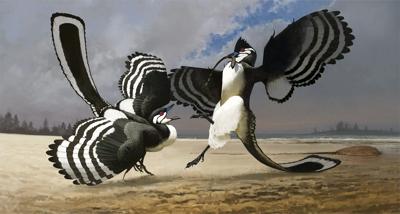In the annals of paleontology, few discoveries have captivated the world's imagination quite like Archaeopteryx. Dubbed the "first bird," this ancient creature straddles the boundary between dinosaurs and modern avian species, offering a glimpse into the evolutionary transition from reptiles to birds. Now, thanks to a recent groundbreaking unveiling at the Field Museum on Monday, May 6, visitors can delve into the rich history and significance of this iconic fossil.
The recent exhibition at the Field Museum, titled "Meet the Chicago Archaeopteryx," marks a watershed moment in the study of prehistoric life. On display is a remarkably well-preserved specimen of Archaeopteryx, providing researchers and enthusiasts alike with unprecedented insight into the anatomy, behavior, and ecological role of this enigmatic creature.
Discovered in the limestone deposits of Germany's Solnhofen Formation, Archaeopteryx lived approximately 150 million years ago during the Late Jurassic period. Its fossilized remains, characterized by the presence of feathers and reptilian features, have long fascinated scientists seeking to unravel the complexities of avian evolution.
The unveiling of the Archaeopteryx fossil at the Field Museum represents a culmination of years of meticulous research and excavation. Dr. Pete Makovicky, the museum's Curator of Dinosaurs, describes the significance of this specimen as "immense," noting that it offers a rare glimpse into the evolutionary transitions that ultimately gave rise to modern birds.
In an article published by WBBM NewsRadio, lead researcher and dinosaur curator Jingmai O’Connnor is quoted as saying. “It’s a small, almost-complete fossil bird — about the size of a pigeon — and it’s preserved in the classic death pose, so it has its neck drawn back,” she said. “It’s the one fossil that showed us that birds are dinosaurs, and it’s also the first piece of evidence that we have for understanding the evolution of birds.”








(0) comments
Welcome to the discussion.
Log In
Keep it Clean. Please avoid obscene, vulgar, lewd, racist or sexually-oriented language.
PLEASE TURN OFF YOUR CAPS LOCK.
Don't Threaten. Threats of harming another person will not be tolerated.
Be Truthful. Don't knowingly lie about anyone or anything.
Be Nice. No racism, sexism or any sort of -ism that is degrading to another person.
Be Proactive. Use the 'Report' link on each comment to let us know of abusive posts.
Share with Us. We'd love to hear eyewitness accounts, the history behind an article.